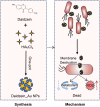Daidzein-Decorated Gold Nanoparticles as a Novel Antimicrobial Strategy Against Carbapenem-Resistant Enterobacteriaceae
- PMID: 40551978
- PMCID: PMC12184690
- DOI: 10.2147/IJN.S515798
Daidzein-Decorated Gold Nanoparticles as a Novel Antimicrobial Strategy Against Carbapenem-Resistant Enterobacteriaceae
Abstract
Introduction: Bacterial resistance to carbapenems is on the rise, and the failure of common antimicrobials poses a serious challenge in treating infections caused by drug-resistant strains. In this scenario, nanomaterials have received widespread attention in medicine.
Methods: In this study, the activity of daidzein-decorated gold nanoparticles (Daidzein_Au NPs) against carbapenem-resistant Enterobacteriaceae (CRE) strains was validated via in vivo and in vitro experiments, such as the microdilution broth method, growth curves, time-killing assays, and an abdominal infection model in mice. The potential mechanisms involved were examined using fluorescence quantification of N-phenyl-1-naphthylamine, propidium iodide, and reactive oxygen species (ROS) levels and transcriptomic analysis.
Results: Face-centered cubic Daidzein_Au NPs with an average size of 25.78 nm and a negative surface charge were successfully synthesized. The minimum inhibitory concentration (MIC) of Daidzein_Au NPs against the tested CRE strains was 8-16 μg/mL, and they exerted a good antimicrobial effect during the dynamic killing process. In vivo experiments showed that Daidzein_Au NPs can significantly enhance the survival rate (100%) and reduce the colony load of ascites in mice (P < 0.05). Furthermore, Daidzein_Au NPs destroyed the permeability of bacterial cell membranes, increased the production of ROS (P < 0.05), and affected the metabolism of CRE strains to play a role in killing.
Conclusion: Daidzein_Au NPs exhibit excellent antibacterial activity and are expected to become a promising solution to the threats posed by CRE strains.
Keywords: Daidzein; antibacterial mechanism; carbapenem-resistant Enterobacteriaceae; gold nanoparticles.
© 2025 Pan et al.
Conflict of interest statement
The authors have no conflicts of interest to declare in this work.
Figures









References
MeSH terms
Substances
LinkOut - more resources
Full Text Sources
Medical

